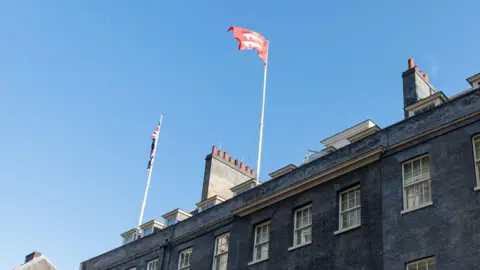Westminster is currently experiencing a political controversy regarding the status of the Middlesex flag and its representation above Downing Street. The discussion centers around whether the Prime Minister’s official residence should continue the tradition of flying the county colors of Middlesex, a practice previously upheld by Conservative governments.
Middlesex itself is a historical county that ceased to exist in the 1960s when it was absorbed into Greater London. Despite its formal dissolution, the Conservatives have advocated for the flag to be flown on May 16, dubbed Middlesex Day, to commemorate the county’s heritage and to honor its significant military contributions, particularly during the Peninsular War against Napoleon. The Labour government, however, has made it clear that there are no plans to permit any county flags to be flown above the Prime Minister’s residence, eliciting accusations from Conservative officials that the Labour ministers display an aversion to traditional British symbols.
These accusations were further echoed by Richard Holden, the shadow paymaster general for the Conservative Party. Speaking to GB News, he expressed disappointment that the Labour government supports flying various modern “woke” flags while neglecting the historic county flags that represent a significant part of Britain’s culture. Although recently hosted celebrations for St George’s Day by the Prime Minister were referenced as a show of respect for heritage, a Downing Street spokesperson reiterated the lack of intention to raise county flags above Number 10.
The tradition of flying the Middlesex flag is relatively new, initiated during Boris Johnson’s tenure, when he served as the MP for Uxbridge and South Ruislip, a constituency that lies within the historical boundaries of Middlesex. The flag continues to be flown at the New Palace Yard in Parliament. On this note, Commons Speaker Sir Lindsay Hoyle acknowledged Middlesex Day via a social media post, highlighting the historical prominence of Middlesex within parliamentary debates, with the county appearing in over 290 recorded titles.
Middlesex Day marks the anniversary of the Battle of Albuhera in 1811, where the Middlesex Regiment and allies from Spain and Portugal successfully resisted Napoleon’s advances. During the intense confrontation, a commanding officer was famously quoted urging his troops to “die hard,” adding a notable historical context to the festivities associated with the flag.
While the geographical and political landscape has changed drastically over the years, the spirit of Middlesex is reflected in modern-day London, notably through the persistence of its name associated with institutions like the Middlesex County Cricket Club. Yet, the geographic significance transcends mere nomenclature; it suggests the enduring legacy that counties maintain within British identity even after administrative changes.
Political discourse around flag-flying in government spaces has been a recurring issue. Recently, the Reform UK party made headlines for attempting to restrict flag display at local councils to only the union jack and the St George’s flag, later refining their stance to permit county flags after backlash. Furthermore, former Home Secretary Suella Braverman criticized the decision to display the Progress Pride flag at the Home Office, reflecting the contentious atmosphere surrounding symbolic representations in governmental spaces.
These discussions inherently raise questions about identity, inclusivity, and the representation of traditional versus contemporary values within Britain’s political fabric. Official guidance indicates that the union jack is to be the primary flag displayed at government properties, relegating other flags to lesser prominence unless specific occasions warrant their display.
In conclusion, the debate over whether to display the Middlesex flag at Downing Street serves as a microcosm of larger societal conversations regarding tradition and modernity. It encapsulates the tension between celebrating historical identity and adapting to contemporary values in a diversifying political landscape.



